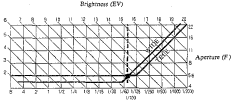
Exposure
Automatic exposure mode
Exposure refers to the amount of the light which strikes the film and is controlled by a combina- tion of aperture size and shutter speed. The
correct amount of the light, or correct exposure,
is controlled according to the film speed (indicated on the film package, such as ISO 100
or ISO 200).
Automatic exposure function automatically sets
the correct exposure. The
With programmed auto exposure, the camera automatically sets the most suitable combination of "F" stop and shutter speed for subjects with a certain brightness. It lets you concentrate on composing your shot and releasing the shutter at just the right time.
With
any "F" stop by yourself, then according to that
aperture, the camera will automatically set the most appropriate shutter speed. Aperture - preferred auto allows greater manual control for more artistic freedom and expression.
Program chart (Standard photography mode)
The chart shown below is a program chart for
35 mm wide and 135 mm telephoto focal lengths. According to the focal length, the program itself changes. When the subject is bright, the "F" stop and shutter speed change simultaneously. When the subject is darker, the aperture opens fully and the shutter speed changes to the corresponding brightness.
In the standard photography mode (refer to
p.13), if the
Shutter speed (second) | |
| – – – Flash |
— 57 —